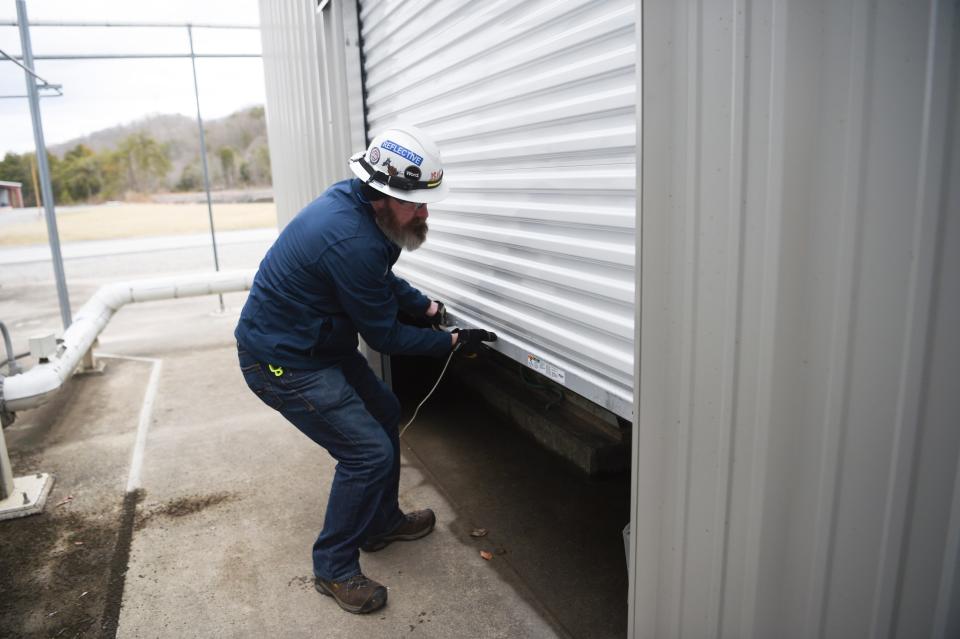Extreme weather is coming, does that mean blackouts? TVA invested $120 million to prepare
The Tennessee Valley Authority has spent $8 million on insulation and heated cables to avoid a repeat of 2022's Winter Storm Elliott, when blasting winds caked its power plants with ice and forced the agency to order rolling blackouts for the first time in its history.
Those winter readiness investments, made over the summer, are a small piece of the agency's broader spending on grid reliability. From October through December 2023, it invested $123 million in the reliability of its coal, gas and hydro facilities, TVA said.
TVA is also betting that new natural gas power will help avoid blackouts during extreme weather. Since Winter Storm Elliott, the agency has added 1,500 megawatts of natural gas generation at plants in Alabama and Kentucky, enough to power nearly 900,000 homes.
Three new units at the Paradise plant in Kentucky came online Dec. 31 and can get to full power in 11 minutes in case of emergency weather, like the extreme cold set to hit the Knoxville region in mid-January, the agency said.
What do those updates look like on the ground? Knox News walked through parts of the John Sevier Combined Cycle Plant, built at the site of a former coal plant in Rogersville, Tennessee, to find out.
At few places were the effects of the December 2022 storm felt more than at natural gas plants such as John Sevier, which are generally more exposed to the elements and more vulnerable to disruptions in the fuel supply chain.
Coal, gas and nuclear plants use water to cool the system and create steam to spin turbines. Water pipes at nuclear plants have the benefit of running through thick containment structures, and hydroelectric dams have the benefit of several feet of concrete.
But pipes at coal and gas plants are often open to the air. If they freeze in frigid temperatures, like during Winter Storm Elliott, they can knock entire generators off the grid right when they are needed most.
“I would say there was some shared pain across the fleet,” John Sevier plant operations manager Jerome Tripp told Knox News. “Continuous improvement comes from pain most times."

Tripp stood over a trailer holding heating equipment, including space heaters and coils of heat trace cable that wrap around pipes to keep them from freezing. The trailer was the idea of operations workers at the plant who worked through single-digit temperatures Dec. 23-24, 2022, to keep the plant online.
They had to grab heating equipment from several different places to thaw an air intake system that froze and briefly knocked out the plant's generating capability. Now they can get the equipment in one location and they recommend other plants do the same.
What happened to TVA during Winter Storm Elliott?
Between its residential and industrial customers, TVA experienced its highest winter power demand in history on Dec. 23, 2022, at 33,427 megawatts — enough to power between 25 million and 35 million homes at once. Residents across the valley were heating their homes for visiting family and firing up their ovens for their holiday roasts and cookies.
Unfortunately, the agency underestimated how much power it would need when Winter Storm Elliott caused temperatures to plummet as much as 45 degrees in just five hours overnight.
When some operators woke up to single-digit temperatures, they learned what their co-workers on the night shift had been dealing with. Several critical systems at sites like the massive Cumberland Fossil Plant, TVA's largest coal-fired generator, had frozen and the utility was producing several thousand megawatts fewer than customers were demanding.

As it lost 38 of its 232 generating units over the next two days, TVA scrambled to avoid a grid meltdown and brought 14 of the lost units back online.
When it normally might have purchased power from a neighboring utility, power companies across the Eastern Interconnection, one of the two largest grids in the U.S., were facing outages of their own.
The nation's largest public power provider took an extraordinary measure, calling on local power companies to initiate temporary controlled blackouts for the first time in TVA's 90-year history. It was a particular crisis for a federal agency that prides itself on public service and the reliability of its system.
TVA was not alone. The North American Electric Reliability Corporation and Federal Energy Regulatory Commission reported in November that TVA was one of six utilities in the Southeast that called for rolling blackouts, including Duke Energy Carolinas.
It was an unprecedented event for the Eastern Interconnection, which normally is able to import and export power to avoid blackouts. The Texas Interconnection, more isolated by comparison, had a disastrous series of outages in February 2021 that likely cost the state economy more than $200 billion.
TVA's blackouts lasted for two hours on Dec. 23 and for six hours on Dec. 24. In an after-action report, TVA said the blackouts cost the utility $170 million.
How will TVA avoid winter blackouts?
Spending $8 million to weatherize its plants is a small price to pay in comparison.
At the John Sevier Combined Cycle Plant, some of the cold weather resiliency work predates Winter Storm Elliott. Workers have added 2,500 feet of heat trace to pipes over the last two years, said operations manager Jerome Tripp.
Combined cycle plants can use either natural gas or liquid fuel, a bonus in extreme weather. If the natural gas supply dries up during peak demand periods, the plant can switch to liquid fuel to power the system.
TVA has increasingly relied on flexible combined cycle gas plants to replace coal plants, swapping one fossil fuel for another as a bridge to cleaner energy.
Some winter readiness updates at the John Sevier plant have been implemented since the storm, such as eight insulating sheet metal structures, like one that now surrounds pipes in the plant's water purification system.
Dozens of tent-like windbreak structures have gone up around exterior pipes at John Sevier since the storm. These changes, as well as emergency response exercises and improvements to communications, have made Tripp feel confident in the plant's ability to withstand a similar storm.
“With the work over the last two years, I’d say we’re well positioned to handle it,” Tripp said. “We’ve done a lot of the work to make sure we’re ready.”
The agency plans to spend an additional $35 million over the next fiscal year, which ends Sept. 30, on advanced winter readiness technologies. These will include monitors connected to control rooms that will give operators time to respond to a failure of the heat trace system before a storm arrives.
During a triage in the months after the storm, TVA found 3,600 updates needed across its fleet and 90% of those updates are completed, said Larry Sparks, general manager of generation outages and project service. The only outlier is the Ackerman Combined Cycle Plant in Mississippi, which is in a prolonged planned outage, he said.
If a winter storm is headed for the region, TVA has a new action plan for five days before the storm and then three days before, when teams will coordinate to ensure plants are ready for impact.
The agency's goal is for its systems to withstand temperatures down to minus-20 degrees Fahrenheit and 20 mph wind gusts for at least 48 hours.
“I believe our approach and forecasting to be able to understand these storms and their expected impact will put us in a very good position," Sparks told Knox News. “We can strengthen and we can make our plants more resilient and we've done that work, but the ultimate test will be in the face of another challenge like Winter Storm Elliott.”
At every hour of every day, TVA's Balancing Authority monitors system conditions, which are updated every two seconds, and make decisions about where power is needed and where it will come from.
After the forecasting failures during Winter Storm Elliott, TVA purchased software upgrades to improve its forecasting tools and partnered with neighboring utilities to share lessons and best practices, a spokesperson told Knox News.
TVA invests millions in grid reliability
TVA followed up insulation investments over the summer with much larger reliability investments in its coal, gas and hydro facilities.
The agency invested $123 million in the three sources, which accounted for 43% of its power generation between Sept. 30, 2022, and Sept. 30, 2023, TVA said in its annual report to the Securities and Exchange Commission.
Nuclear accounted for 42% of its power generation, and was the only power source unaffected by Winter Storm Elliott.
Over the next fiscal year, TVA will invest an additional $120 million on reliability and resiliency as it continues to deal with peak summer and winter loads and a growing population of customers.
The agency is currently building 3,800 megawatts of additional generation and has entered into new supply contracts for 1,000 megawatts of purchased power since the storm.
Daniel Dassow is a growth and development reporter focused on technology and energy. Phone 423-637-0878. Email daniel.dassow@knoxnews.com.
Support strong local journalism by subscribing at knoxnews.com/subscribe.
This article originally appeared on Knoxville News Sentinel: Will TVA avoid Tennessee rolling blackouts like Winter Storm Elliott

